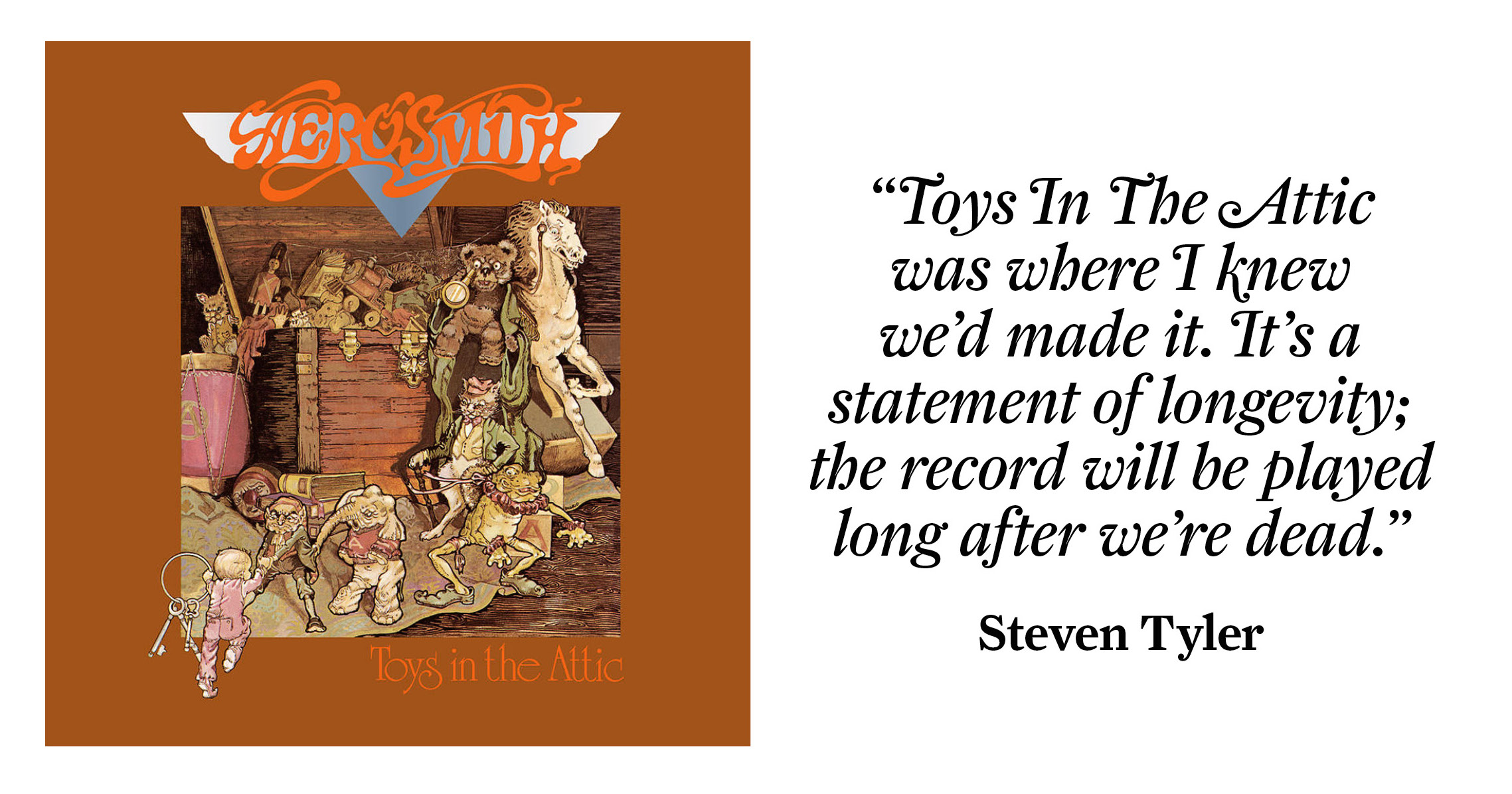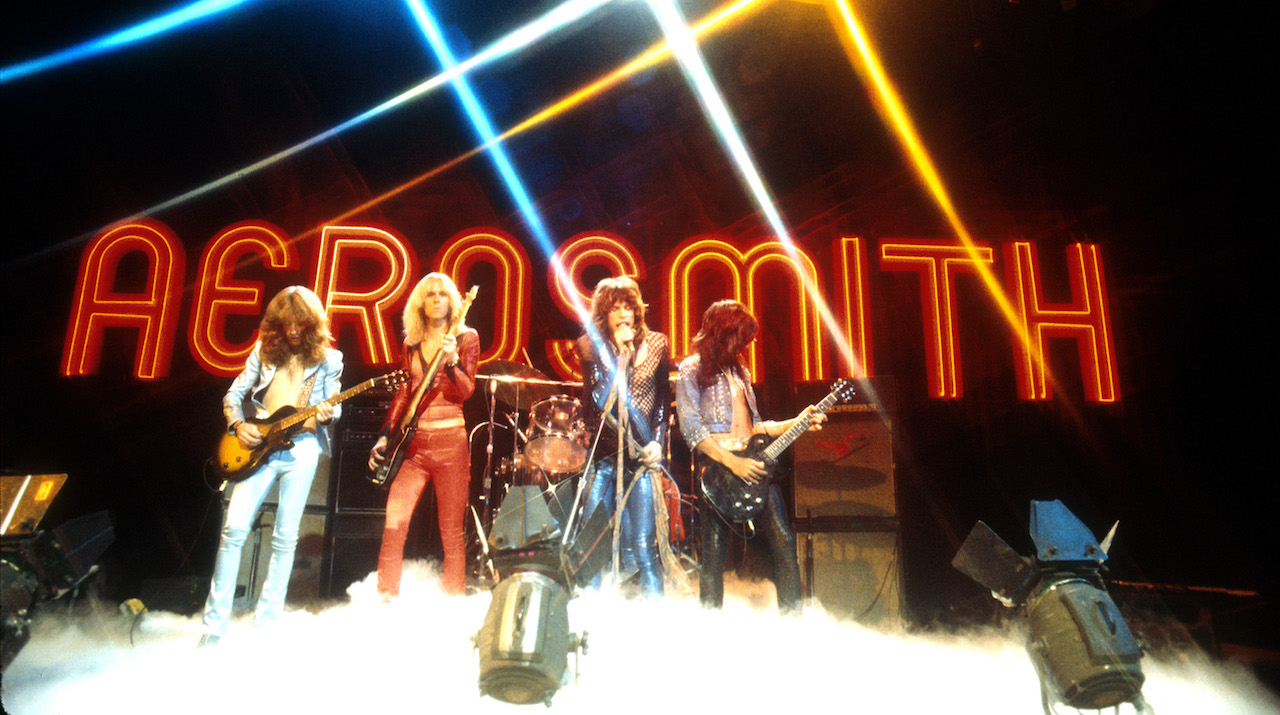Midtown Manhattan, January 1975. In the early hours, five skinny, hirsute young men are hustling along the yellow line in the middle of 8th Avenue near West 44th Street, huffing out against the frigid air, laughing nervously and keeping an eye peeled for muggers. They’re right to be wary. New York in the 70s is a dangerous place. In 1975 alone, there will be 1,645 murders and 83,190 robberies. But despite the grit, grime and near bankruptcy of the city, it is still the greatest place on earth and, more importantly, the ultimate proving ground for a rock band on the rise like Aerosmith.
“I can remember walking back to the Ramada Inn from the Record Plant, literally in the middle of the street,” Joe Perry tells Classic Rock, with a laugh. “I only had a couple guitars back then, and I always carried my favourite one with me, a fifty-nine Les Paul. We would walk down the middle of the street at four or five in the morning, because it was the safest place. We didn’t want to get too close to the dark alleys.”
The music business had its own dark alleys and statistical casualties, and the band adopted a similar strategy of sticking together on the road. After their 1973 self-titled debut fell short of label expectations, selling only 30,000 copies, they lived in limbo, wondering if Columbia Records would drop them. But for Perry, Steven Tyler, Joey Kramer, Tom Hamilton and Brad Whitford failure was never an option. “The thought that we might not make it never occurred to us,” Tyler wrote in his autobiography. “Everybody was totally committed.”
They toured relentlessly, like “gypsies possessed”, as Tyler put it. They got tighter. Their songs got better. Along the way they won fans while putting the fear into – and often upstaging – headliners such as Mott The Hoople, Kiss, Black Sabbath and Slade. “We were very competitive,” bassist Tom Hamilton says today. “There’s a lot of bands I like and respect now, but back then all I did was think of them as the people we wanted to blow off the stage.”Before Aerosmith’s second album, when producer Bob Ezrin famously pronounced them “not ready”, the band doubled down with even more we’ll-show-’em bravado. Get Your Wings, produced by Jack Douglas and powered by FM rock tracks Same Old Song And Dance and Train Kept A-Rollin’, scored well enough to get them back in favour with Columbia. Expectations were high for the third record.
Forty years on, that third, Toys In The Attic, stands out as a milestone, the album that lifted the group from scrappy openers to headlining superstars. With more than eight million copies sold, and classic rock hits Walk This Way and Sweet Emotion still sounding amazingly vital, Toys is the perfect distillation of Aerosmith’s edgy guitar riffage, lewd humour and high-energy strut, and one of the first albums to proudly hoist the American flag in the rock pantheon alongside those by their Brit heroes The Who, the Stones and Led Zeppelin. “Toys has some of the most important songs we ever wrote,” says Perry. “It set the precedent for how the band worked over the years to come, reshaped our sound and gave us a huge amount of confidence.”
The confidence that had been building on the road carried over into the studio. “We were playing bigger venues before bigger crowds,” says Perry. “Detroit, Cincinnati, Cleveland. We felt like if we could win the heart of America, the rest of the country would follow. And through constant touring we learned what kinds of songs and grooves went over best. As a songwriter you start thinking in terms of: ‘If I was sitting in the audience, what would I want to hear?’ That gave new focus to the songs that ended up on Toys.”
The final tour dates in December ’74 were three sold-out headlining shows in their home town of Boston. After a holiday break, the band spent a week with producer Jack Douglas in a converted barn in Ashland, Massachusetts, jamming and sorting through song ideas. “Jack was like the sixth member of the band,” Perry says. “He had great ears and was really encouraging.”
“He knew how to have authority, how to really tell us what he thought and get us to try to new stuff,” Hamilton adds. “He challenged us to get better. At the same time, he had this insane sense of humour, so it was a really fun process. We’d take the raw ideas that Steven and Joe brought in and rehearse the living shit out of them. There was a lot of camaraderie and laughter.”
Arriving in NYC in the middle of what Steven Tyler called “a spine-chilling, ball-freezing winter”, Aerosmith started tracking Toys at the Record Plant during the second week of January, 1975. In the world outside, the Weather Underground bombed the US State Department’s office in DC, Margaret Thatcher was elected leader of the Conservative Party in Britain and Space Mountain opened at Disney World. But inside the studio it was all about reaching for the greatness of their heroes.
“The Record Plant was like hallowed ground,” says Perry. “It was the first stop for anybody who was anybody. It was the place you went for rock. It was up there with Muscle Shoals and Sun Studio. In the preceding years you could pick out the four seats in front of the board and go: “Mick sat there, Jimi sat there, Janis sat there.”
“You also had the Jimi Hendrix bathroom, with mirrors on the floor, ceiling and walls,” Hamilton adds with a chuckle. “He wanted it that way because he would go in there and do acid. And then you had the giant John Lennon acoustic guitar. Someone must’ve challenged the guitar maker to see how big he could make a guitar. So you have this eight-foot high acoustic. Unplayable, but fun to look at it.” “The Record Plant was like the coolest nightclub you’ve ever seen,” engineer Jay Messina recalls. “Plush carpeting, dim lights. I remember walking into Studio A for the first time, and The Who were doing vocals. The vibe of the place was totally electric. I knew that’s where I wanted to work.”
With Douglas out on the floor with the band, Messina manned the board and 16-track tape machine in the control room. “My basic approach was to capture the energy of Aerosmith,” says Messina. “Getting the right moment on tape is far more important than any recording techniques. And with Steven’s vocals it was always easy. He always had that edge that was just naturally there, so you wouldn’t have to do anything extra to help him. His voice cut through. He had attitude, great phrasing and pitch. We would record a few takes, then he and Jack would comp the best lines and bounce it to one track. But all the takes were usually great. You know that joke today, where the singer does a take and asks the engineer: ‘How was that?’ And the engineer says: ‘It sucked. Come on in.’ There are so many things you can do now to fix a vocal, but it ends up sounding sterile or auto-tuned. Back then, without that safety net, the singers had to be on their game. And Steven was.”
And then there were those monster guitar sounds. Messina laughingly recalls an experiment where “Jack and I set up thirteen amps, mic’d them all, then fed one guitar into all of them, just to see if it would sound thirteen times better than one amp. The answer was no. If you had one good amp, that was better.”
And the Record Plant had that amp. “It was a fifty-watt Fender Twin from the 1950s,” says Perry. “Every guitar player who came through the Record Plant played through it. It had an amazing sound. Of course, it’s not about the amp or guitar as much as who’s playing it. So I could play through that amp and it would’ve sounded totally different than Pete Townshend, Lowell George or Alex Lifeson. Funny thing: a friend of mine was helping me build my studio, and when the Record Plant closed down, he was able to buy that amp, and he’s lent it to me over the years. To have that in my house is a really special thing. I played the guitar parts on Walk This Way and Same Old Song And Dance through that amp.”
- "Mix Aerosmith members together and we explode": The confessions of Joe Perry
- Steven Tyler: a little bit country, a little bit rock'n'roll
- Brad Whitford Q&A: “Aerosmith is a colossal pain in the ass”
- The top 10 best Mick Jagger Rolling Stones songs
Like the amp, the Aerosmith guys were workhorses. Fuelled by pastries from Pozzo’s Italian Bakery and sirloins from Downey’s Steakhouse, they worked 16 hour days, six days a week, through the end of February. Songs went to tape, every one with its own distinct flavour: the hard-nosed raunch of Adam’s Apple; the delta blues of Uncle Salty; the horn-fuelled swinging cover of the old Bull Moose Jackson tune Big Ten Inch Record; and the two swaggering tunes that would help make Aerosmith’s career.
What New York Dolls singer David Johansen once called “the nastiest song I’ve ever heard on the radio” began with a dose of inspiration from New Orleans and ended with another from Mel Brooks.
“I was very into funk like The Meters and Sly And The Family Stone at the time,” Perry says of Walk This Way. “So I felt inspired listening to this Meters song Hey Pocky A-Way, and thought maybe it’s time for us to come up with something of our own in this groove. I wrote the riff and chords in Hawaii before a show. The guys heard it, found their parts, and it evolved from there. Joey had played in R&B bands, so that groove was his meat and potatoes. When we got into the studio we recorded the track, but it was missing the lyric hook. Steven had the melody. He was about ninety per cent there.
“One evening, we felt like we needed a break, so the guys went off to see Young Frankenstein. I’d already seen it. When they came back they were all laughing, and Jack was doing an imitation of Marty Feldman as Igor, saying: ‘Walk this way.’ Someone said: ‘Hey, that would be a great title for the song!’ Steven heard that, grabbed a pad and a pen, ran off and came back two hours later with the lyric.”
Tyler remembers it differently. “I’d actually finished the song the night before our session and kept it in a bag that had all the other lyrics I’d written for the LP. Arriving that day at the studio at four pm, I got out of the cab and realised that I’d left the bag in the car! Gone. Two hours later I went upstairs. I sat down on the steps with my pen and wrote the words to Walk This Way on the wall. As I rewrote each line, the words all came back to me. Never saw the bag again.”
Curiously for such an acknowledged classic, the song failed to chart in its first run, in 1975, but on re-release a year later, climbed to No.10 in the US. It’s proto-rap delivery would boomerang around 10 years later for an even bigger impact, when their collaboration with Run DMC took the song into the Top 5 and introduced Aerosmith to a new generation.
One of the hallmarks of a classic song is that you can recognise it from the opening bars, and what Steven Tyler calls “Tom Hamilton’s slippery, slimy, melodically delicious” intro on Sweet Emotion is up there with the great bass riffs of all time.
“I remember going out on the roof of my house, smoking a bit of weed, then picking up the bass,” Hamilton says, “and this intro popped out. Then I started getting some guitar ideas for it. But I was shy about bringing my ideas into rehearsals. In New York, we had finished the basic tracks and had an extra day in the studio, and Jack says: “Does anybody have any ideas that we haven’t tried yet?” I raised my hand and we started working on it. We cut the song the same day, and everybody was saying: “Nice one, man!” After we finished the basic tracks, because of the budget Joey, Brad and I went back to Boston, and Steven and Joe stayed to do overdubs. A month later the album was finished. When I heard the final version of Sweet Emotion it blew my mind. I never knew it would become one of our most popular songs. What a great feeling. Something I can cling to. I can put that on my name tag: Sweet Emotion Guy!”

Despite the title, the lyric found Tyler in attack mode. When they weren’t on the road in the early 70s, Joe and Steven were roommates. Then Joe moved out to be with his girlfriend, Elyssa. “I was angry at Elyssa because she stole my boyfriend, my significant other, my partner in crime,” Tyler recalled. “It was like losing a brother. So now there was jealousy, this dark undercurrent humming along. And I put it into Sweet Emotion, which I pointed at Elyssa directly.” ‘You talk about things that nobody cares/You’re wearing out things that nobody wears/Calling my name but I gotta make clear/I can’t tell ya honey where I’ll be in a year.’
Of course, by now there was an even darker undercurrent starting to move through the band. Cocaine and pot were part of most 70s rock bands’ daily regimen, but Aerosmith were becoming, as Kramer put it, “the single biggest market for drugs in New England”. And the band had regular “production meetings” in the studio whenever they needed extra inspiration.
Hamilton reflects: “I don’t want to sound pro-drug or anything, but there is something about being high that makes you look at things differently. But that period for some people can be relatively short, where the weed is helping you get into a different state of mind. But the cocaine was different. I’ve never been diagnosed as ADD [attention deficit disorder], but the more I’ve thought about it I must be. I’m so distractable. But the cocaine that I was doing was almost acting like an underground version of Ritalin [a stimulant used to treat ADD]. I think it gave us all energy and concentration. It was beneficial for a while during this time. But in a few years it became so destructive. It was just so awful. We worked hard to be able to play with feelings and be really tight, and then after Rocks it fell apart. We started making a lot of money, and that was the beginning of the end.”
Toys In The Attic was released on April 8, 1975. In the year of Physical Graffiti, Elton John’s Captain Fantastic and Bowie’s Young Americans it held its ground as a major contender. Three weeks after finishing up the album, the band were already into another run of touring – this time as headliners – that would take them through the end of the year. Fittingly, they ended in New York. Your correspondent, then at the tender age of 11, was at their triumphant Madison Square Garden show.
“It was just as exciting for us as it probably was for you,” Perry tells me with a laugh. “The first time we headlined the Garden was huge. Like the old song says, once you make it there you can make it anywhere.”
The rest of the band’s saga lay ahead – the unravelling amid drugs and breakups; the 80s reinvention; the sobriety; the survival; and, this year, Aerosmith Rocks Donington, a full-length concert film (“It was a particularly strong show,” says Perry). But without Toys there might not have been any saga worth recounting.
“We were pretty wet behind the ears on the first two albums, but Toys is where we got deep,” says Hamilton. “When I listen to it, it reminds me of what it was like to be with the band and Jack in New York in the Record Plant, and having that great comradeship as you set out on the adventure of making a big album. That’s as much as why it’s my favourite as the actual songs.”
“Toys In The Attic was where I knew we’d made it,” said Tyler. “[With that title] I was the kid who put my initials in the rock ’cos I wanted the aliens to know I was there. It’s a statement of longevity; the record will be played long after you’re dead. Our records would be up there in the attic, too, with the things that you loved and never wanted to forget. And to me, Aerosmith was becoming that. I knew how The Beatles, The Animals and The Kinks did it – with lyrics and titles. I saw reason and rhyme in all the lunacy that we were concocting.”
“It arrived at the moment when I think rock’n’roll albums were becoming an important part of people’s lives,” says Perry. “It was an important ritual, waiting for a record to come out, going to the record store the day it was released, buying it, taking it home, cracking the plastic, dropping the needle, sitting down in front of the stereo and listening to every song while you stared at the cover and read the liner notes. The experience was bigger than the record itself. And that’s part of why Toys has endured.”
This article originally appeared in Classic Rock #210.

